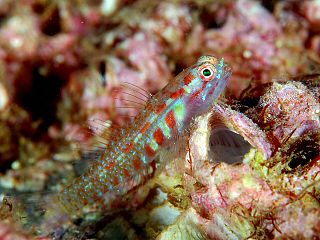
Eviota is a genus of fish in the family Gobiidae, commonly as dwarfgobies found in the Indo-Pacific region, where it is distributed from Japan to Australia and from Africa to Pitcairn Island. Species are mainly associated with coral reefs. Many of these fish are short-lived, with life cycles as brief as 3.5 weeks in the tropics. Some species are hermaphrodites and some representatives live symbiotically among the tentacles of the mushroom coral.

Amblyeleotris is a genus of fish in the family Gobiidae found throughout the Indo-Pacific region. This is the largest genus of the shrimp gobies or prawn gobies, so-called because of their symbiotic relationship with certain alpheid shrimps. The shrimp excavates and maintains a burrow used by both animals while the goby, which has far superior eyesight, acts as a lookout for predators. The shrimp maintains almost constant contact with the fish with an antenna. Fossil Amblyeleotris otoliths have been found together with alpheid shrimp remnants from as early as late early Miocene (Burdigalian) suggesting a possible mutualistic association since then.

Acentrogobius is a genus of gobies native to marine, fresh and brackish waters of the coasts of the Indian Ocean and the western Pacific Ocean.
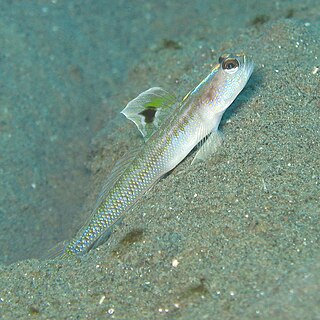
Vanderhorstia is a genus of gobies native to the Indian and Pacific oceans. The name of this genus honours the Dutch biologist Cornelius van der Horst (1889-1951) of the University of the Witwatersrand, Johannesburg, who was well known for his interest in marine biology.

Cryptocentrus, also known as Watchman gobies, and one of the genera known as shrimp gobies or prawn gobies, is a genus of gobies native to tropical marine waters of the Indian and Pacific oceans.

Tomiyamichthys russus, the Ocellated shrimpgoby, is a species of marine ray-finned fish belonging to the family Gobiidae, the typical gobies. This species is found in the Eastern Indian Ocean and Western Pacific Ocean.

Asterropteryx is a genus of fish in the family Gobiidae found in the Indian and Pacific Ocean.

Grallenia is a genus of gobies native to the western Pacific Ocean.

Kelloggella is a genus of fish in the family Gobiidae, the gobies. This genus is distributed in the Indian and Pacific Oceans. The genus name honours the American entomologist Vernon Lyman Kellogg (1867-1937) of Stanford University, the discoverer of Kelloggella cardinalis.
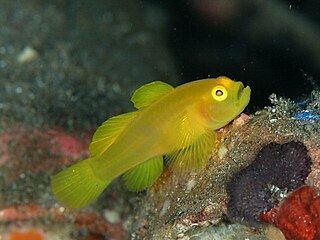
Lubricogobius is a genus of fish in the family Gobiidae found in the Pacific Ocean.
Mahidolia is a small genus of gobies native to the Indian Ocean and the Western Pacific Ocean. Both species are commensal with species of alpheid shrimps.
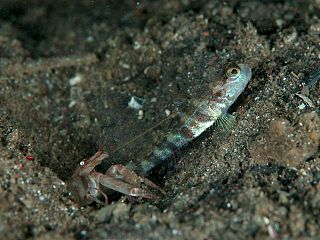
Myersina is a genus of ray-finned fish from the family Gobiidae, the true gobies which are found from the Atlantic coast of South Africa through the Indian Ocean to the western Pacific Ocean. The generic name honours the American ichthyologist George S. Myers (1905-1985) who was a younger colleague of Herre's at the time at which he described the genus and who went on to be president of the American Society of Ichthyologists and Herpetologists, the head of the Division of Fishes at the United States National Museum and an ichthyologist for the United States Fish and Wildlife Service.
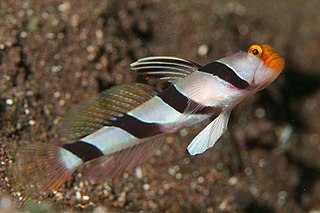
Stonogobiops is a genus of gobies native to the Indian and Pacific oceans. This is one of the "shrimp goby" genera, the members of these genera being commensal with various species of shrimps.
Sueviota is a genus of fish in the family Gobiidae native to the Indian and Pacific Ocean.

Trimma is a genus of fish in the family Gobiidae native to the Indian and Pacific Ocean. Together with members of the genus Eviota, they are known commonly as pygmygobies or dwarfgobies.
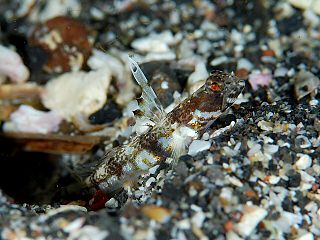
Tomiyamichthys alleni, Allen's shrimpgoby, is a species of ray-finned fish from the family Gobiidae. It occurs in the western Pacific Ocean where it is commensal with an aplheid shrimp.
Helen K. Larson is an ichthyologist who specialises in the fishes of the Indo-Pacific.

Tomiyamichthys oni, the monster shrimpgoby, is a species of goby in the family Gobiidae. It is found in the western Pacific Ocean, including Japan, New Guinea, Indonesia, Philippine Islands, Sabah, Palau, and New Caledonia.
Sueviota minersorum, commonly known as the Miner's dwarfgoby, is a species of small, cryptic fish in the family Gobiidae. This species was described in 2019 by David W. Greenfield, Mark V. Erdmann, and Ilham Vemandra Utama.
Tomiyamichthys elliotensis, commonly known as the Lady Elliot shrimp goby, is a species of small, symbiotic shrimpgoby from the Great Barrier Reef, specifically Lady Elliot Island in Queensland, Australia. This species was described in 2023 by Gerald R. Allen, Mark V. Erdmann, and Chris L. Dudgeon.















